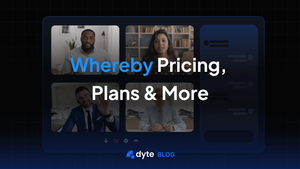As remote collaboration began to reshape the landscape of communication, Whereby emerged as a key player in connecting people — from business conferences to personal interactions. Its intuitive interface made it a popular choice for those venturing into video conferencing for the first time. Yet, the scope of Whereby's functionalities has its boundaries.
This brings us to the distinct features of Whereby's Video SDK, diverging from the standard version that most are accustomed to. It allows for seamless integration into your own digital environment. However, its previous success doesn't necessarily imply it's the perfect fit for your current requirements.
What should you weigh when deciding on a Video Conferencing SDK? Consider the variety of features available, the customization potential for your specific needs, the integration process into your existing systems, scalability, and pricing.
In these aspects, Whereby often leaves room for improvement.
Let's delve deeper.
Whereby: Recognizing Its Limitations
While Whereby has made strides in simplifying video conferencing with its user-friendly interface, its SDK version, particularly the newly released Whereby Browser SDK V2 Beta with React hooks, reveals certain limitations.
- Interactive Limitations: While the Whereby Video SDK has been updated with new features, it may still have limitations in certain interactive capabilities, such as advanced real-time collaboration tools, in-depth customization options, or integrated audience engagement features compared to other comprehensive video communication platforms.
- Video Call Focus: Primarily supports video calls, making it less suitable for scenarios that need comprehensive communication tools like real-time messaging, file sharing, and collaboration features.
- Audience Specificity: Primarily designed for basic video communication, this service might not be ideal for specialized uses like telehealth, online education, or advanced corporate training, which require more specific features.
- Resource Usage: Tends to use more CPU and memory resources, possibly affecting performance efficiency.
- Support Gaps: Support and documentation, especially for newer features, might not be comprehensive enough for all developers.
- Integration Challenges: Embedding the SDK into applications can be complex, especially for sophisticated use cases.
- Limited Roles: The service offers only two user roles – Host and Participants. This could be limiting for applications that require a more diverse range of user roles.
At the end of the day, it all comes down to pricing. Let’s get a deeper understanding of Whereby SDK pricing.
But if you are reconsidering Whereby, then we have a list of Whereby video SDK alternatives ready. Let’s also explore how Whereby compares with other major platforms like Zoom and Jitsi. For detailed insights and comparisons, you can visit our dedicated pages on Whereby vs Zoom and Whereby vs Jitsi, where we delve into the features, advantages, and suitability of each platform.
Whereby Pricing: The Critical Decision Point
Pricing details are key, and Whereby's SDK pricing structure offers some insights, though it could be more transparent. Whereby allows easy integration with just a few lines of code, offering a fully branded, customizable solution for platforms.
Dyte and Whereby both provide free usage tiers, with Dyte offering 10,000 free credits and Whereby including 2,000 participant minutes each month, catering to different user needs and preferences
Let's compare them on various aspects.
Video and Audio
Whereby's SDK pricing is usage-based. It charges $0.004/minute after the initial 2,000 free minutes. This rate applies for both audio and video sessions, with no distinction in pricing between them. Additionally, Whereby emphasizes a user-friendly and feature-packed experience that is fully customizable.
💡 Dyte's pricing remains at $0.004/user/minute for video and drops to $0.001/user/minute for audio.
💡 Did you know that Dyte also provides 10K free credits every month for your video experiences?
Missing Features
Whereby offers features like breakout groups, screen sharing, chat, waiting rooms, and background effects. However, removing Whereby branding is only possible with Pro or Business plans.. Whereby's infrastructure is scalable, supporting growth with consistently high-quality video call experience~~】~~.
If you're interested in a comparison of Zoom vs Whereby. Check this out!
💡 Dyte provides plugins and whiteboard features for free, while Whereby does not explicitly mention these.
Recording
Recording is vital for various purposes, from education to business. Whereby charges $0.01/minute for cloud recording.
💡 Dyte, in contrast, offers a flat rate of $10 for every 1,000 minutes recorded.
Storage
Storage is a critical aspect, and Whereby charges $0.0015 per GB per day. The 'Build' plan includes 30 GB days, while the custom plan offers 300+ GB days. The Whereby team provides resources aimed at assisting users with quick starts and business development
💡 Dyte provides the first seven days of storage for free, then charges AWS pass-through rates.
HIPAA Compatibility
Whereby does not provide specific information about HIPAA compliance pricing on their website, which might require direct inquiry for those in the healthcare sector.
The absence of clear information on HIPAA compliance costs with Whereby could be a concern for healthcare sector clients who need to ensure compliance without incurring unexpected expenses.
💡 Dyte offers HIPAA compliance that certifies your platform and gives it credibility at just $500 per month.
Support
Effective support is essential for developers using SDKs. Whereby offers customer success managers and technical onboarding in its custom plan.
💡 Dyte provides free support 24x7, contrasting with Whereby's more limited and tier-based support options.
Closing Thoughts
Dyte, a developer-oriented video SDK, simplifies customization and scalability. Its array of intuitive features includes virtual backgrounds, breakout rooms, messaging, surveys, analytics, and more. This makes it an adaptable video conferencing SDK suitable for various applications. If you need a dependable video SDK that integrates swiftly, Dyte is an excellent choice.
Dyte stands out for its high adaptability and the ability to meld seamlessly with your current systems and applications through Dyte's API. Furthermore, Dyte's UI kit allows for crafting a unique video conferencing environment that aligns with your brand.
In search of a developer-centric video SDK enriched with extensive functionalities? Discover your answer in Dyte. Explore now!



